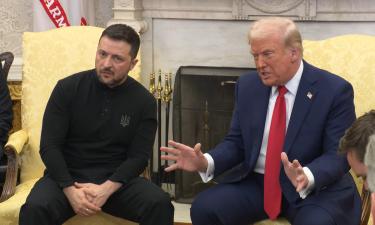Autopsy On Gujarat
Peace has returned to Gujarat after large-scale death and destruction. Gujarat symbolizes a national malaise wrongly diagnosed. It will not disappear with the disappearance of Narendra Modi (its chief minister) or a BJP (federal) government. The state was the scene of such violence several times even in the past when the Congress party was in power. Political parties, and unfortunately the media too, are reluctant to accept hard realities. The first mistake is in considering the recent conflict as a sudden and independent eruption. It has been waiting to happen. Waiting for a spark. To link it to Godhra or Ayodhya is to reject a very tenable and visible catalyst. That catalyst is the history of communal strife in the country. That history unfolds itself in episodes, each recurring and repeating an earlier one in substance though not in detail.
Look at the latest episode. First, a mob in Godhra, near Gujarat's capital, sets ablaze a train carrying devotees returning from Ayodhya, killing nearly 70 persons. Next, angry crowds unleash an unmanageable and statewide retaliation, destroying life and property of people who had very little to do with the Godhra arson. The army and the police swing into action. The opposition paralyses Parliament business for ten days. The government names a Supreme Court judge to probe and submit a report. The judge will take a decade to complete the report, a decade which is bound to see more Godhras and Ahmedabads. This is an endless serial of gory tragedy in which the Hindus and Muslims alternate roles as the aggressors and the victims.
This cycle of mindless violence has been visiting the country relentlessly for the last half a century. Every such visit is followed by ritualistic and autopsical responses. Pretending that such mayhems have no chance in a secular state is the basic mistake. If they are the work of the lunatic fringe, such lunacy will persist and spread as long as the core of the country's secularism is embedded in religion. Why did the Indians forget that religion was behind the partition of the country? Why did they oppose the two-nation theory and yet meekly accept a division of the country on religious basis? The country is now paying the price of such contradictions and will continue to pay until it resolves this basic antithesis between religion and a secular republic.
These religious killings are not new or recent because they have been happening with sickening frequency since the direct action launched by Husain Shaheed Suhrawardy in 1946. We may overlook the 800-year-old history of Hindu-Muslim discord because history has been written and rewritten so many times that it has become mythology. But there are millions of people who are still living who can testify to the Direct Action holocaust of 1946 that became the strongest argument in favor of partition. In August 1947, India and Pakistan celebrated their independence, rolling a pall over the bodies of millions of people killed in the savage religious reprisals. Religion killed them.
And what did the country do to neutralize the mortal might of religion? It crowned it in its Constitution and yet called it secular. When Pakistan was born in bloodshed, large Muslim population (18 million) stayed back in India gladly accepting its secular framework. This dйtente was shattered when the constitution makers grafted into the statute an article that would regard the minorities not as citizens but as followers of their faith. Thus the Congress pioneered a political tradition of seeing Muslims as voters and not citizens. This encouraged the resurgence of the Muslim League that won Pakistan on the two-nation platform. This kind of secularism utterly failed to foster communal harmony as Jinnah-type politicians began raising their ugly heads. The Congress and other parties conferred political respectability on these communal outfits by accommodating them in coalitions led by them or by signing pre-election seat sharing with them.
Several times, the Supreme Court of India tried to define the frontiers of religious privileges. Nearly every political party, mainly the Congress, thwarted such efforts. For instance, the bill to reserve seats for women in Parliament could not even be tabled because the secular parties demanded that the seats be distributed on a religious basis. What secularism is anybody talking about? The secularism of religious primacy? The media and the secular parties painstakingly created a mindset among the minorities, which does not allow them to appreciate the freedom they enjoy and to regard themselves as part of the Indian society. The media prominently feature attacks on the minorities and impart them a permanent sense of persecution. Such attempts by secular parties to just garner votes and by the media to appear liberal and secular will do great harm to the minorities who gave the country such patriots like Abul Kalam Azad, Rafi Ahmed Kidwai and now Abdul Kalaam.
I am afraid that media experts in the country are on a wrong track in their analyses of Gujarat conflict. The seeds of division have been laid as early as the approval of the Constitution, guaranteeing rights to sections of the people on the basis of their faith and caste. Even before freedom, the constitutional reforms of 1909 created special electorates for religious minorities. The first draft of the Constitution published in 1948 made no reference at all to them. The Congress regarded minority safeguards as unnecessary to maintain political balance between different communities despite a different view held by the Cripps mission. When the Constituent Assembly discussed the minority's question, the dominant opinion insisted on removal of economic and social disabilities instead of granting special safeguards and guarantees to religious and caste groups.
There was opposition to the very mention of the term 'minority' which in later stages disappeared from the sections dealing with group preferences. Such favors were regarded as inimical to the principles fundamental to the founding of a new democratic state. Listen to what Nehru had said at that time: "If you seek to give special safeguards to a minority, you isolate it. Maybe, you protect it, but at what cost? At the cost of isolating it and keeping it away from the main current in which the majority is going, at the cost of forgetting that inner sympathy and fellow feeling with the majority." Moulana Hasrat Mohani (UP) objected to the word 'minorities.' Speaking in the Constituent Assembly on 28 August 1947, he said, 'I refuse to accept Muslims to be a minority. Now, you say you have done away with communalism. Are we not calling a minority only to refer to Muslims?' 'Nationalism and not religion is the basis of modern life,' said Dr S.Radhakrishnan.
By accepting partition on the basis of religion, the Congress party legitimated the thesis that religion could be the context for nation making. After taking over the reins of power from the British on behalf of the entire nation, the party began drafting a constitution for the country and sanctified religion by conferring privileges and safeguards on minorities, on the basis of their faith. Thus they gave constitutional recognition to the communal divide.
In the end, the Article conferring privileges on religious groups became India's nightmare and precursor of today's communal and caste conflict. It is this miscalculation of minority status at the very beginning of a free Indian state laid the foundation for secessionist movements based on religion as evident from the Naga, Khalsa and Kashmir subversive agitations. It does not make much sense in talking in terms of numerical minorities and majorities in assessing threats to the country's stability and integration. The Indian media plead the cause of the minorities, which is praiseworthy. But the media's overemphasis on the minorities' sense of insecurity and discrimination herd them into insular ghettos. A better thing for the media would be encourage them to join the mainstream even while keeping their cultural identities.
Dasu Krishnamoorty
Subscribe to Pravda.Ru Telegram channel, Facebook, RSS!




